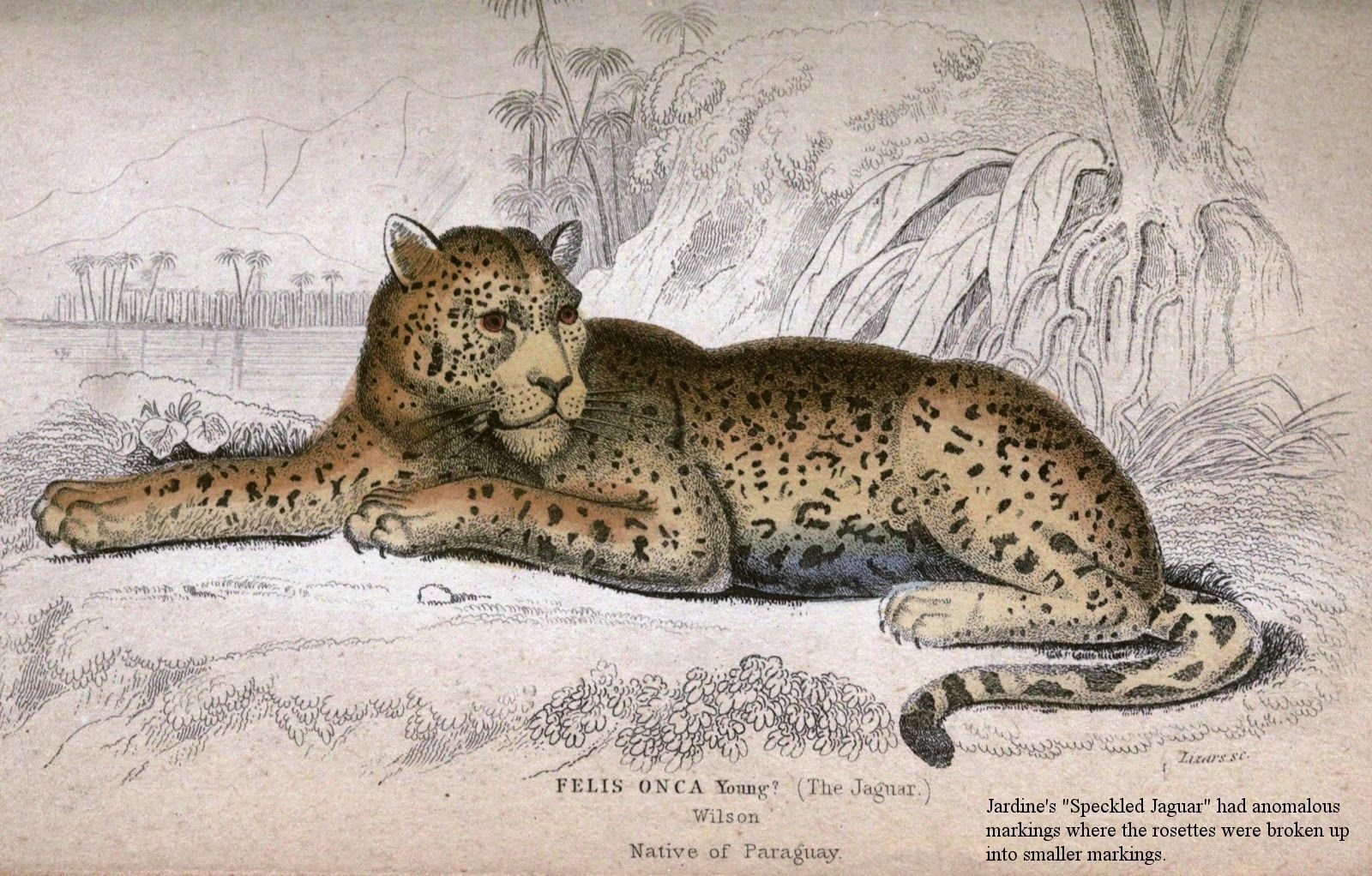
|
MUTANT JAGUARS |
Mutants are natural variations resulting from spontaneous genetic changes or the expression of recessive (hidden) genes due to inbreeding. Albinism (pure white), melanism (black) and unusual marking patterns are the commonest mutations. Such mutations occur in domestic cats so why are they less common in big cats? Wild cats displaying these traits may be less likely to survive to pass on the traits. In captivity, humans control which traits are bred, hence the multitude of domestic cat colours and types. In the wild, nature selects against any trait which does not enhance the animal's survival chances.
In the past, the obvious reaction to any unusual big cat was to shoot it for the trophy room. As a result, many interesting mutations may have been wiped out before the genes were passed on. Some colour mutations which would disadvantage a wild big cat are bred in captivity and are not viable in the wild. It is questionable whether these mutants should be perpetuated for the sake of curiosity or aesthetics alone.
SPECKLED JAGUAR, LEOPARD SPOTTED JAGUAR

NOTICE OF A NEW SPECIES OF JAGUAR FROM MAZATLAN, LIVTNG IN THE GARDENS OF THE ZOOLOGICAL SOCIETY. By Dr. J. E. Gray, V.P.Z.S., F.R.S., etc, Proceedings of the Zoological Society, 1857:- The Society has recently received from Miss Mary Knight a very curious and valuable animal from Mazatlan, which appears not hitherto to have been noticed in the systematic catalogues, which is the more extraordinary, as the zoologists in the United States are now very active in describing the animals of North America, and are evidently renaming several of those which are well known in the European Museums. This species greatly resembles the Jaguar in size, character, and marking, having the short legs and short tapering tail of that species ; but it chiefly differs from that animal in the form of the head, which is more elongate, and in the disposition of the spots; instead of the spots being all placed in rings or roses, as they are usually called, the spots on the front part of the body are single and scattered, and those on the hinder part of the body are alone placed in rings or roses. I propose to distinguish the species provisionally with the name of Leopardus Hernandesii, waiting until its skull and other characters can be more carefully examined and compared before I undertake to give its proper specific character.
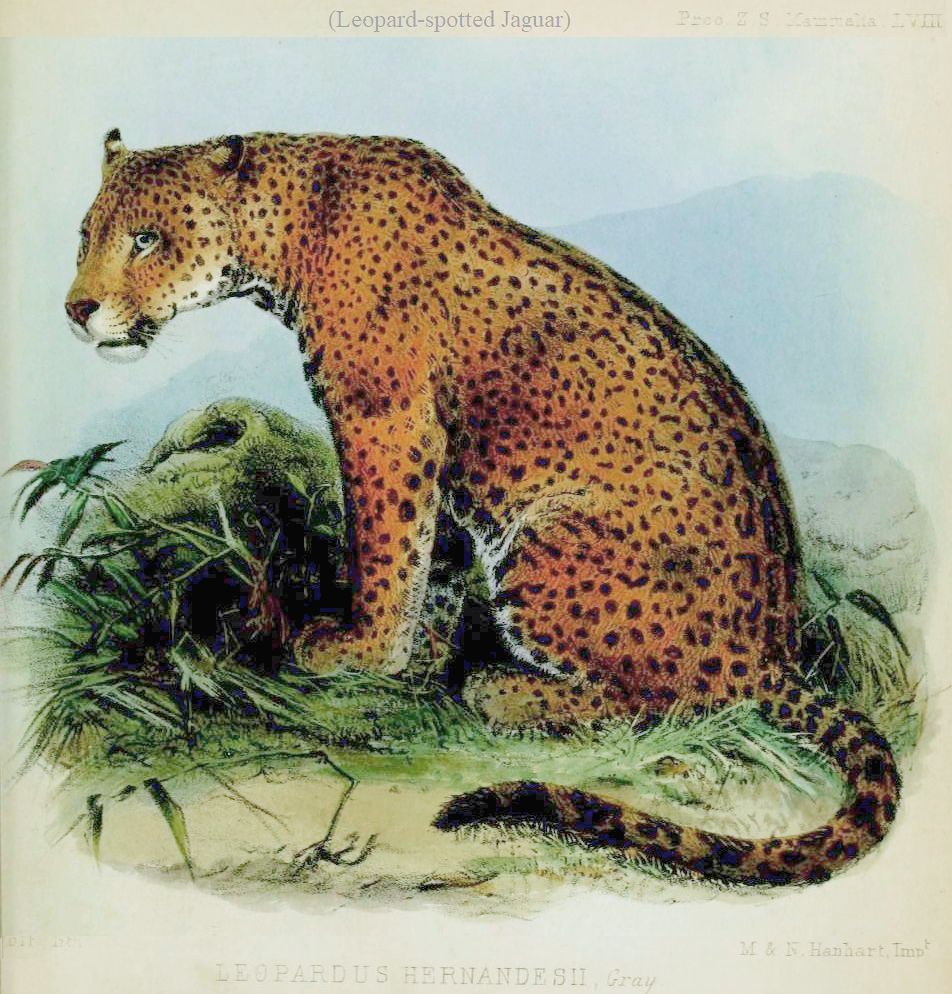
Leopard-spotted jaguars are reported sporadically from the Peruvian rainforest.
BLACK JAGUAR
The black jaguar is a relatively well known mutation. Black jaguars have been reported from Esmeralda, Venezuala and the junction of the Casiquiare and Orinoco rivers, also from south-eastern Brazil and from Paraguay (where Rengger (1830) reported black and chestnut skins). The black jaguar's spots still show up as the spot colour is denser than the background colour. Interestingly, melanism in jaguars is the result of a dominant gene (the gene is incompletely dominant and cats with 2 copies of the gene are darker than those with only one copy). In most other cat species it is a recessive (normally hidden) mutation. Black jaguars do not seem in any way disadvantaged by their mutation.
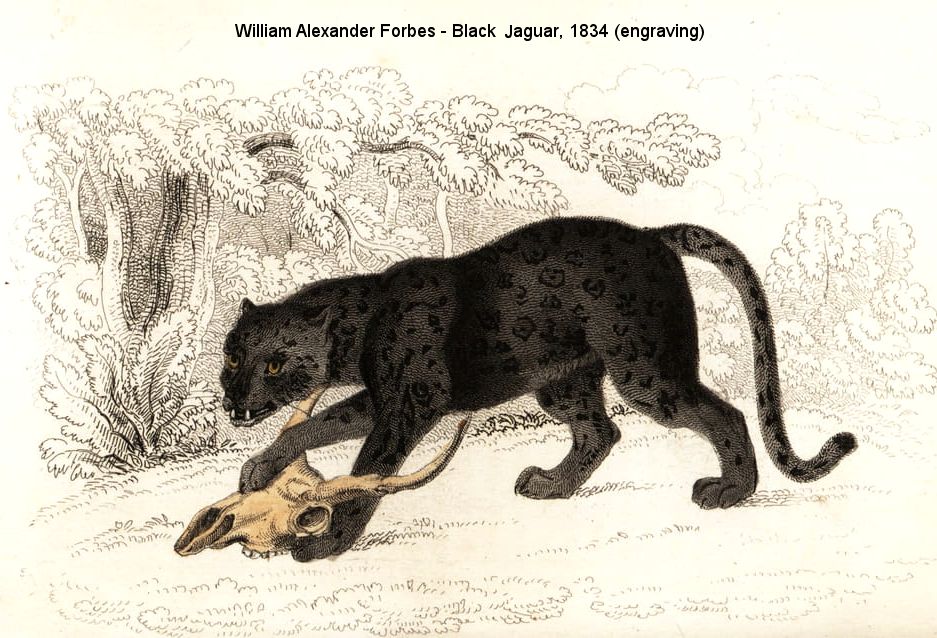
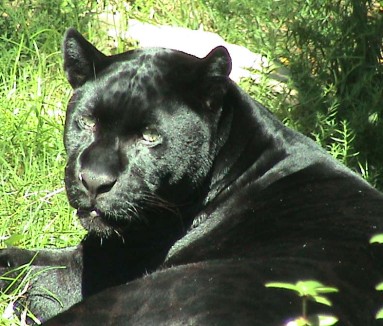
Black jaguar Kon (named for the Incan god of rain and wind) at Philadelphia Zoo |
According to the "Illustrated Natural History" by the Rev JG Wood (1853, 1874): Sometimes, a black variety of the Jaguar is found, its colour being precisely similar to that of the Black Leopard, mentioned on page 169. The whole fur seems to take the tint of the dark spots, while the spots themselves are just marked by a still deeper hue. Probably, the cause of this curious difference in tint may he, that in the blood of the individual Jaguar there exists a larger quantity than usual of iron, which metal, as is well known, is found to form one of the constituents of blood. It can be extracted in the metallic form, and resembles very fine sand. In the human blood, late researches have discovered that the blood of the negro is peculiarly rich in iron, and it seems but reasonable that a similar cause will account for the very great variation in the leopard's and Jaguar's fur.
In Harmsworth Natural History (1910), WH Hudson " The jaguar is a beautiful creature, the ground-colour of the fur a rich golden-red tan, abundantly marked with black rings, enclosing one or two small spots within. This is the typical colouring, and it varies little in the temperate regions; in the hot region the Indians recognise three strongly marked varieties, which they regard as distinct species - the one described; the smaller jaguar, less aquatic in his habits and marked with spots, not rings; and, thirdly, the black variety. They scout the notion that their terrible 'black tiger' is a mere melanic variation, like the black leopard of the Old World and the wild black rabbit. They regard it as wholly distinct, and affirm that it is larger and much more dangerous than the spotted jaguar ; that they recognise it by its cry; that it belongs to the terra firma rather than to the water-side; finally, that black pairs with black, and that the cubs are invariably black. Nevertheless, naturalists have been obliged to make it specifically one with Felis onca, the familiar spotted jaguar, since, when stripped of its hide, it is found to be anatomically as much like that beast as the black is like the spotted leopard. "
PSEUDO-MELANISTIC JAGUAR
According to the Atlantic Journal, and Friend of Knowledge, Volume 1, by Constantine Samuel Rafinesque (1833) there was a form of jaguar with a wide black marking along its back: But another Jaguar still larger and of a different species has lately been seen as far as Lake Erie, and lat. 42. One was shot by the Seneca Indians, to whom it was totally unknown, another was killed in the Alleghany mountains of Pennsylvania, and an account given in the papers. These animals were totally distinct from the common Jaguar; they must have been wanderers from New Mexico or the Oregon mountains, and belong probably to a new species which I propose to call Felis dorsalis, owing to the black band on the back. There are several other species of Jaguars in South America, little known or not well distinguished. Specific characters, Felis Dorsalis, Dorsal Jaguar. Of a grey colour, neck fallow, a black line or band all along the middle of the back, two rows of ringed spots on each side, black above, brown below. Total length 10 feet including the tail, body 6-and-half, tail 5-and-half. Very different from Felis pardalis by size four times larger, neck and back, &c.
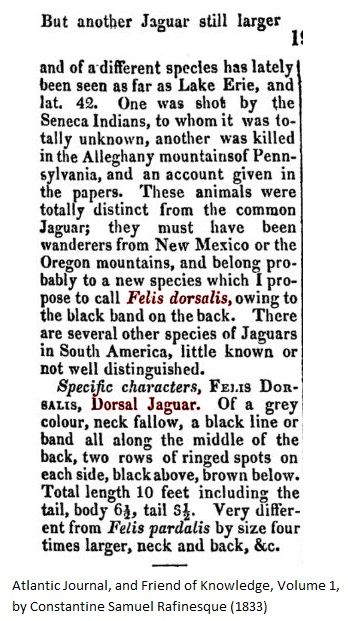
Below is Hemmer's pseudo-melanistic jaguar in which the markings have coalesced (merged) to give a blotched appearance. This is called abundism because markings are more abundant than normal. Some pseudo-melanistic jaguars have been reported as being black with tan or buff underparts, chest and throat (like a black-and-tan dog). On rare occasions, the black spots coalesce to produce a jet plack individual.
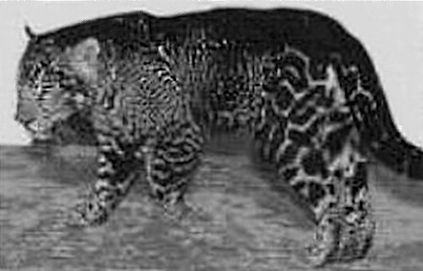
This appears to be "Johnny" who was born at London Zoo in September 1965. "Johnny the jaguar cub posed for the photographers for the first time yesterday - spitting and snarling for all he was worth. Six-week-old Johnny, pictured above in the gloved hand of a keeper at London Zoo, was furious at being parted from his mother Juno. But soon the ordeal was over, and Johnny went happily back to her. Juno and her mate Gerry were both brought to London from the jungles in Brazil three years ago." According to the Zoological Society of London, Johnny was sold to the Chipperfields at Southampton Zoo. As well as being in the circus business, the Chipperfields were animal dealers and traded with circuses and menageries across Europe, hence Johnny ended up in Germany. In 1961, Jimmy Chipperfield leased a one and a quarter acre site on Southampton Common for a Zoological Pets Corner. The reality was a tiny 'Pets Corner' and a zoo housing bears, big cats, giraffes, zebras, chimps etc, in small enclosures. Jimmy's daughter, Mary Chipperfield, used the zoo as a base for training performing animals. The poor welfare of the animals at Southampton Zoo was highlighted by Born Free actress, Virginia McKenna and the zoo finally closed in 1985 due to new legislation.
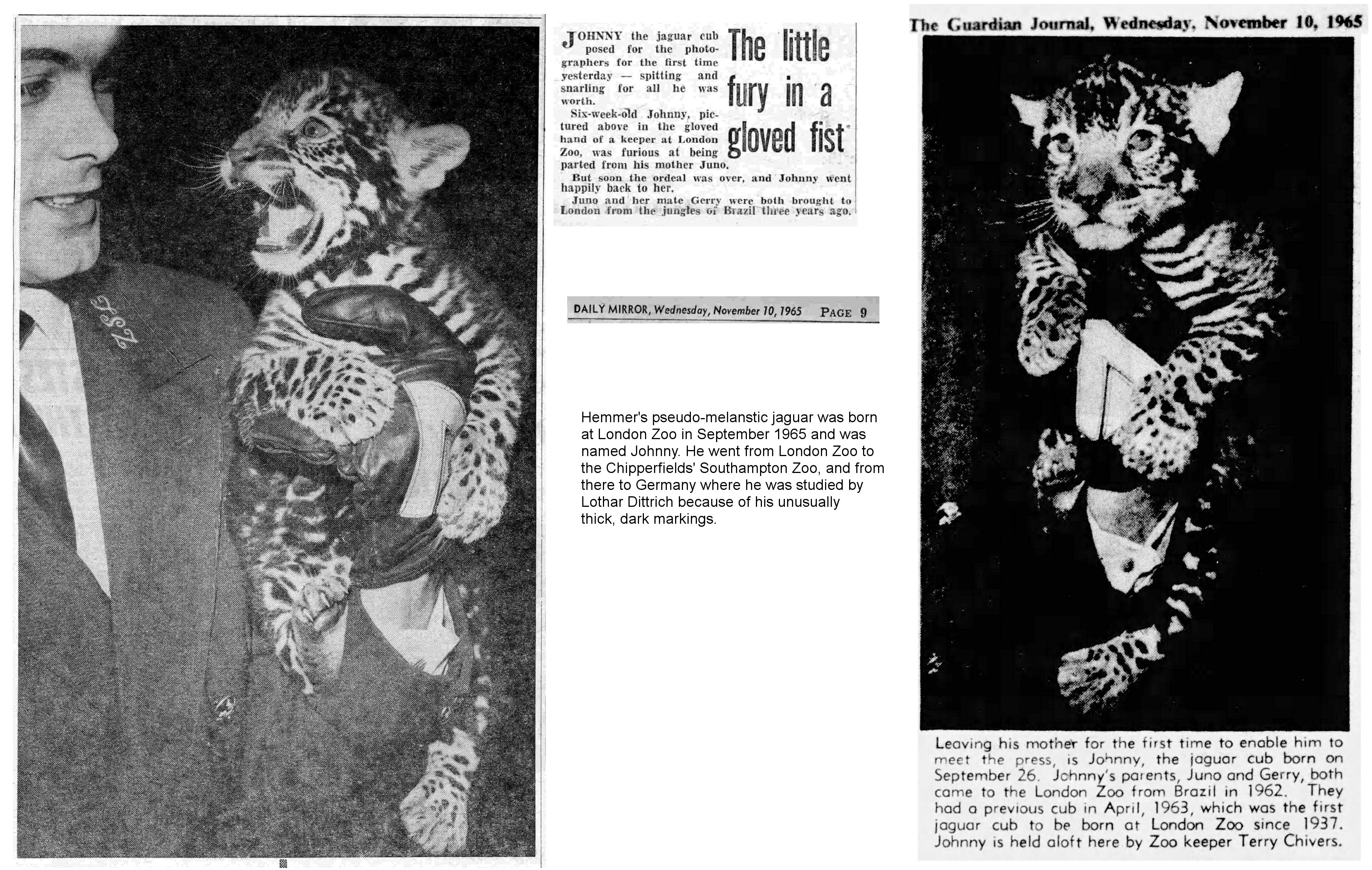
Hemmer's pseudo-melanistic jaguar was described by Dittrich in 1979:
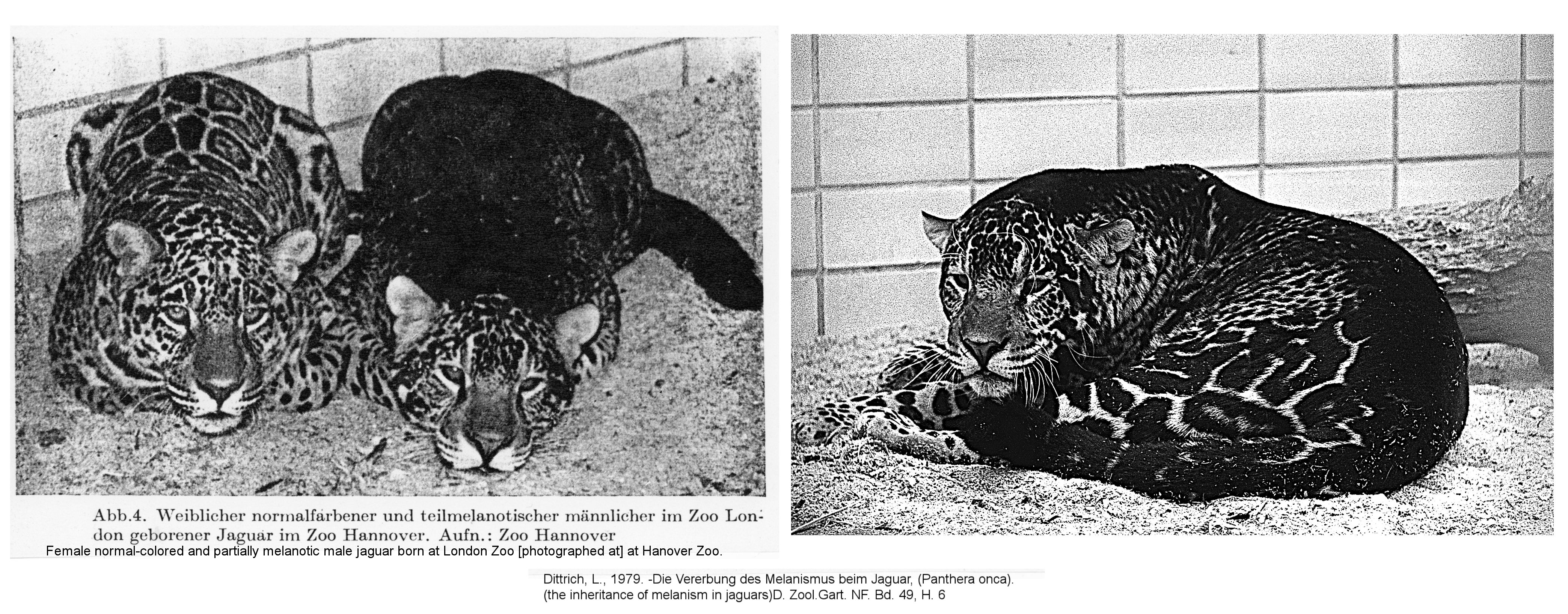
PIEBALD JAGUARS
Low-grade white spotting (low-grade piebaldism) in cats typically involves the chin, throat, paws and inner thighs and is a mutation of the KIT gene. Low-grade white spotting has been photographed in the Canada lynx and the leopard. There are a few reports of jaguars with white markings in parts of Brazil, though no photographs. Leaving aside reports of these jaguars being larger than normal jaguars, or hunting in pairs, the descriptions are consistent with the distribution of low grade white spotting in domestic cats.
The onca-cangucu (white-throated black jaguar) is described by Marc van Roosmalen as being jet-black, excepting a splotchy white bib-like pattern on the throat. There are no visible rosettes. It reportedly exists in the Mato Grosso and Amazonas States of Brazil near the Madeira and Aripuana rivers. This could be a homozygous black jaguar with the equivalent of the domestic cat's white throat locket. Jaguars that have 2 copies of the dominant melanism gene may be jet black, though their rosettes tend to be visible at certain angles, something hard to see in the wild.
According to Joana Macedo (2016) an onca-da-coleira-branca (white-collared black jaguar) and onca-preta-do-peito-branco (white-breasted black jaguar) are also mentioned by locals. The white collared jaguar has a strip of white fur around its neck while the white breasted black jaguar has a white chest.
Although a cub of the white-throated black jaguar was killed by local people, the skin was not preserved. It's worth noting that most witnesses are unlikely to have been close enough to see if there were white markings on the lower belly or inner thighs of an adult animal encountered in the wild.
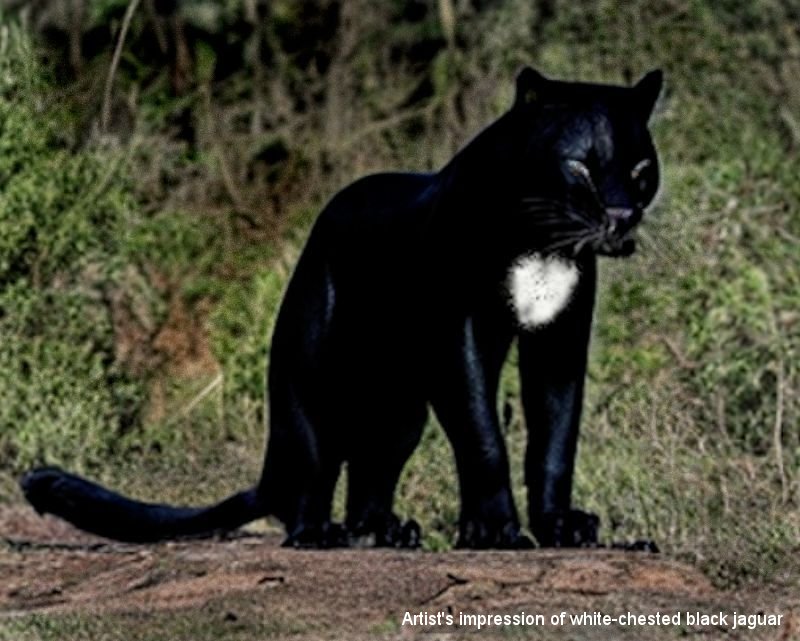
WHITE JAGUAR (LEUCISTIC/ALBINO) & "GHOST" JAGUAR
"Ghost jaguars" are sometimes reported. They have greyish white fur with faint markings on the flanks and have been reported in Paraguay. Albino jaguars with almost invisible markings have also been reported. Albino and partially albino jaguars have been reported from Paraguay. Spanish soldier-naturalist Don Felix de Azara described a jaguar so pale that its rosettes were only visible in certain lights. Rengger described a greyish white skin with faint shades of markings on the belly and flanks, the claws had been white according to the hunter who shot the animal.
In March 2012, a pair of white jaguar cubs were born at the Aschersleben Zoo in the state of Saxony-Anhalt, Germany. The parents were a 17-year-old spotted male named Mescal and 13-year-old black female named Molly (Molly was jet black rather than black-on-charcoal, indicating she was homozygous for melanism). The cubs have pale grey markings on a white background. The markings are darker on the points (head, tail and lower limbs) and also on the back. This may indicate a temperature-related form of albinism, similar to that seen in Siamese cats. White, or very pale, cubs can be due to a condition known as fever coat which is well-known to cat breeders. If the temperature in the womb is unusually high, for example the mother is unwell, melanin production is inhibted in the growing foetuses. The cubs are born paler than normal, sometimes with unusual reddish or bluish tones in places. The cubs develp a normal adult colour when they moult. So don't count your jaguars as white until after the first moult! If the cubs stay pale, then either both parents both carry a recessive gene for the colour, or one or other parent has a novel dominant mutation in the germ cells (the eggs or sperm) - this would show up in the offspring, but not in the parents. It would be necessary to mate the cubs back to the parents, and to unrelated jaguars, to determine whether the mutation is dominant or recessive.
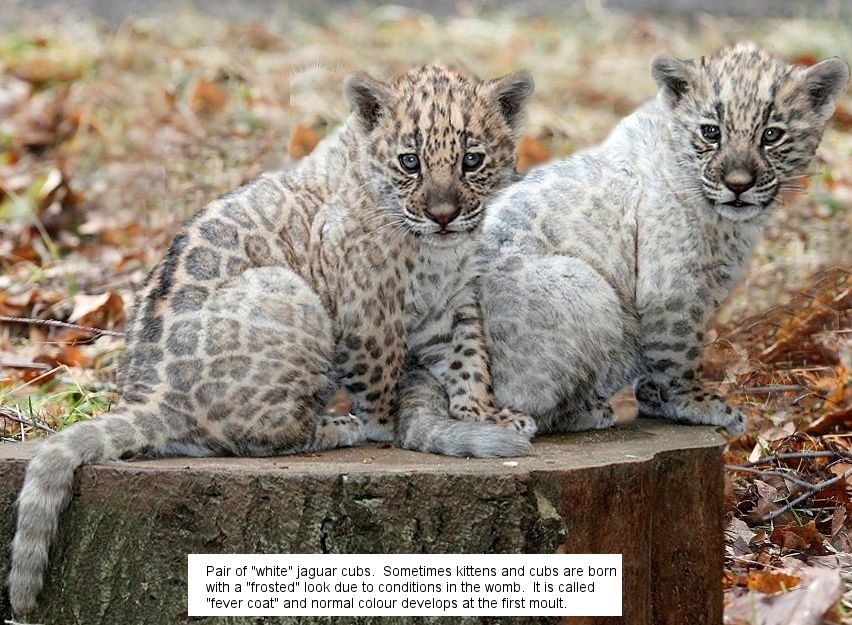
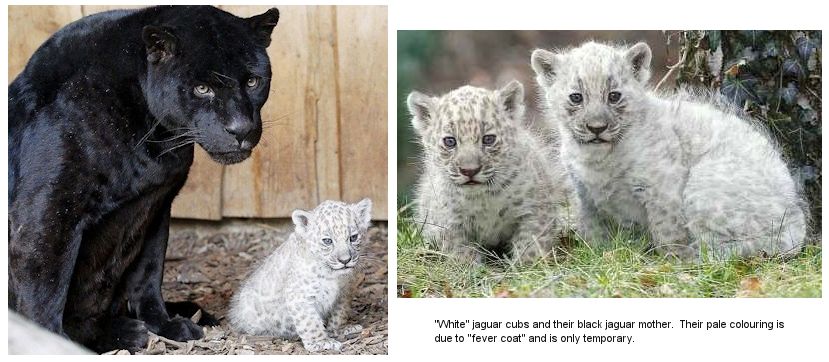
RED JAGUAR
There is also the possibility of red (erythristic) jaguars resulting from the non-extension gene although I am not aware of any reports (the red mutation has been seen on several occasions in leopards).
Textual content is licensed under the GFDL.
For more information on the genetics of colour and pattern:
Robinson's Genetics for Cat Breeders & Veterinarians 4th Ed (the current version)
Genetics for Cat Breeders, 3rd Ed by Roy Robinson (earlier version showing some of the historical misunderstandings)
Cat Genetics by A C Jude (1950s cat genetics text; demonstrates the early confusion that chinchilla was a form of albinism)
For more information on genetics, inheritance and gene pools see:
The Pros and Cons of Inbreeding
The Pros and Cons of Cloning
For more information on anomalous colour and pattern forms in big cats see
Karl Shuker's "Mystery Cats of the World" (Robert Hale: London, 1989 - some of the genetics content is outdated)
|
BACK TO HYBRID & MUTANT BIG CATS INDEX |